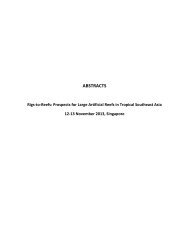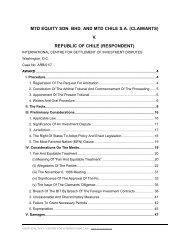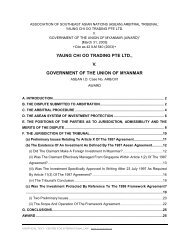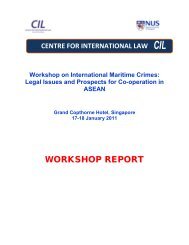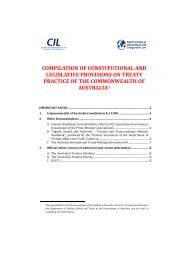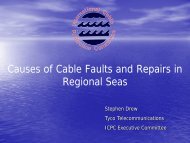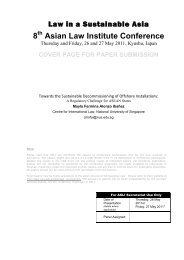UNCLOS - Centre for International Law
UNCLOS - Centre for International Law
UNCLOS - Centre for International Law
You also want an ePaper? Increase the reach of your titles
YUMPU automatically turns print PDFs into web optimized ePapers that Google loves.
jurisdiction.<br />
5. When laying submarine cables or pipelines, States shall have due regard to cables or pipelines<br />
already in position. In particular, possibilities of repairing existing cables or pipelines shall not<br />
be prejudiced.<br />
Article 86: Application of the provisions of this Part (Provisions on High Seas)<br />
The provisions of this Part apply to all parts of the sea that are not included in the exclusive<br />
economic zone, in the territorial sea or in the internal waters of a State, or in the archipelagic<br />
waters of an archipelagic State. This article does not entail any abridgement of the freedoms<br />
enjoyed by all States in the exclusive economic zone in accordance with article 58.<br />
Article 87: Freedom of the high seas<br />
1. The high seas are open to all States, whether coastal or land-locked. Freedom of the high seas<br />
is exercised under the conditions laid down by this Convention and by other rules of<br />
international law. It comprises, inter alia, both <strong>for</strong> coastal and land-locked States:<br />
(a) freedom of navigation;<br />
(b) freedom of overflight;<br />
(c) freedom to lay submarine cables and pipelines, subject to Part VI;<br />
(d) freedom to construct artificial islands and other installations permitted under international<br />
law, subject to Part VI;<br />
(e) freedom of fishing, subject to the conditions laid down in section 2;<br />
(f) freedom of scientific research, subject to Parts VI and XIII.<br />
2. These freedoms shall be exercised by all States with due regard <strong>for</strong> the interests of other States<br />
in their exercise of the freedom of the high seas, and also with due regard <strong>for</strong> the rights under<br />
this Convention with respect to activities in the Area.<br />
Article 112: Right to lay submarine cables and pipelines<br />
1. All States are entitled to lay submarine cables and pipelines on the bed of the high seas beyond<br />
the continental shelf.<br />
2. Article 79, paragraph 5, applies to such cables and pipelines.<br />
Article 113: Breaking or injury of a submarine cable or pipeline<br />
Every State shall adopt the laws and regulations necessary to provide that the breaking or injury by<br />
a ship flying its flag or by a person subject to its jurisdiction of a submarine cable beneath the high<br />
seas done willfully or through culpable negligence, in such a manner as to be liable to interrupt or<br />
obstruct telegraphic or telephonic communications, and similarly the breaking or injury of a<br />
submarine pipeline or high-voltage power cable, shall be a punishable offence. This provision shall<br />
apply also to conduct calculated or likely to result in such breaking or injury. However, it shall not<br />
apply to any break or injury caused by persons who acted merely with the legitimate object of<br />
saving their lives or their ships, after having taken all necessary precautions to avoid such break or<br />
injury.<br />
Article 114: Breaking or injury by owners of a submarine cable or pipeline of another submarine<br />
cable or pipeline<br />
Every State shall adopt the laws and regulations necessary to provide that, if persons subject to its<br />
jurisdiction who are the owners of a submarine cable or pipeline beneath the high seas, in laying or<br />
repairing that cable or pipeline, cause a break in or injury to another cable or pipeline, they shall



